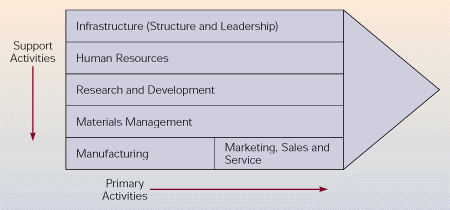Texts belong to their owners and are placed on a site for acquaintance.
Strategy and the Firm
The fundamental purpose of any business firm is to make a profit. A firm makes a profit if the price it can charge for its output is greater than its costs of producing that output. To do this, a firm must produce a product that is valued by consumers. Thus, we say that business firms engage in value creation. The price consumers are prepared to pay for a product is a measure of the value of the product to consumers.
Firms can increase their profits in two ways: by adding value to a product so that consumers are willing to pay more for it and by lowering the costs of value creation (i.e., the costs of production). A firm adds value to a product when it improves the product's quality, provides a service to the consumer, or customizes the product to consumer needs in such a way that consumers will pay more for it; that is, when the firm differentiates the product from that offered by competitors. For example, consumers will pay more for a Mercedes-Benz car than a Hyundai car because they value the superior quality of the Mercedes. Firms lower the costs of value creation when they find ways to perform value creation activities more efficiently. Thus, there are two basic strategies for improving a firm's profitability--a differentiation strategy and a low-cost strategy.1
The Firm as a Value Chain
It is useful to think of the firm as a value chain composed of a series of distinct value creation activities including production, marketing, materials management, R&D, human resources, information systems, and the firm infrastructure. We can categorize these value creation activities as primary activities and support activities (see Figure 12.1).2
Primary Activities
The primary activities of a firm have to do with creating the product, marketing and delivering the product to buyers, and providing support and after-sale service to the buyers of the product. We consider the activities involved in the physical creation of
Figure 12.1
The Firm as a Value Chain

the product as production and those involved in marketing, delivery, and after-sale service as marketing. Efficient production can reduce the costs of creating value (e.g., by realizing scale economies) and can add value by increasing product quality (e.g., by reducing the number of defective products), which facilitates premium pricing. Efficient marketing also can help the firm reduce its production costs (e.g., by generating the volume sales necessary to realize scale economies) and can add value by helping the firm customize its product to consumer needs and differentiate its product from competitors' products--both of which facilitate premium pricing.
Support Activities
Support activities provide the inputs that allow the primary activities of production and marketing to occur. The materials management function controls the transmission of physical materials through the value chain--from procurement through production and into distribution. The efficiency with which this is carried out can significantly reduce the cost of creating value. In addition, an effective materials management function can monitor the quality of inputs into the production process. This results in improved quality of the firm's outputs, which adds value and thus facilitates premium pricing.
The R&D function develops new product and process technologies. Technological developments can reduce production costs and can result in the creation of more useful and more attractive products that can demand a premium price. Thus, R&D can affect primary production and marketing activities and, through them, value creation.
An effective human resource function ensures that the firm has an optimal mix of people to perform its primary production and marketing activities, that the staffing requirements of the support activities are met, and that employees are well trained for their tasks and compensated accordingly. The information systems function makes certain that management has the information it needs to maximize the efficiency of its value chain and to exploit information-based competitive advantages in the marketplace. Firm infrastructure--consisting of such factors as organizational structure, general management, planning, finance, and legal and government affairs--embraces all other activities of the firm and establishes the context for them. An efficient infrastructure helps both to create value and to reduce the costs of creating value.
The Role of Strategy
A firm's strategy can be defined as the actions managers take to attain the goals of the firm. For most firms, a principal goal is to be highly profitable. To be profitable in a competitive global environment, a firm must pay continual attention to both reducing the costs of value creation and to differentiating its product offering so that consumers are willing to pay more for the product than it costs to produce it. Thus, strategy is often concerned with identifying and taking actions that will lower the costs of value creation and/or will differentiate the firm's product offering through superior design, quality, service, functionality, and the like.
Consider the case of Clear Vision, which is profiled in the accompanying Management Focus. A US-based manufacturer of eyeglasses, Clear Vision found its survival threatened by low-cost foreign competitors. To deal with this threat, Clear Vision adopted a strategy intended to lower its cost structure: shifting its production from a high-cost location, the United States, to a low-cost location, Hong Kong. Clear Vision later adopted a strategy intended to differentiate its basic product so it could charge a premium price. Reasoning that premium pricing in eyewear depended on superior design, its strategy involved investing capital in French, Italian, and Japanese factories that had reputations for superior design. In sum, Clear Vision's strategies included some actions intended to reduce its costs of creating value and other actions intended to add value to its product through differentiation.